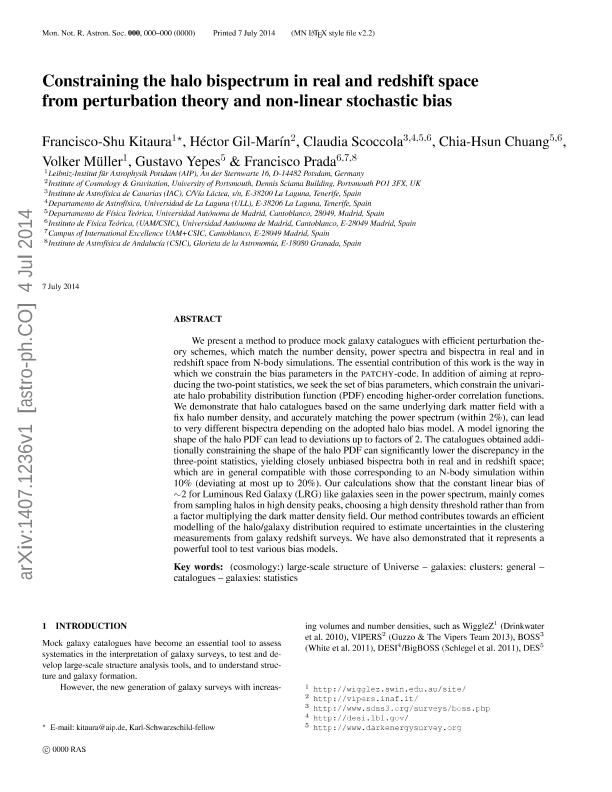Mostrar el registro sencillo del ítem
dc.contributor.author
Kitaura, Francisco-Shu
dc.contributor.author
Gil Marín, Héctor
dc.contributor.author
Scoccola, Claudia Graciela

dc.contributor.author
Chuang, Chia-Hsun
dc.contributor.author
Müller, Volker
dc.contributor.author
Yepes, Gustavo
dc.contributor.author
Prada, Francisco
dc.date.available
2018-07-30T17:39:50Z
dc.date.issued
2015-04
dc.identifier.citation
Kitaura, Francisco-Shu; Gil Marín, Héctor; Scoccola, Claudia Graciela; Chuang, Chia-Hsun; Müller, Volker; et al.; Constraining the halo bispectrum in real and redshift space from perturbation theory and non-linear stochastic bias; Wiley Blackwell Publishing, Inc; Monthly Notices of the Royal Astronomical Society; 450; 2; 4-2015; 1836-1845
dc.identifier.issn
0035-8711
dc.identifier.uri
http://hdl.handle.net/11336/53430
dc.description.abstract
We present a method to produce mock galaxy catalogues with efficient perturbation theory schemes, which match the number density, power spectra and bispectra in real and in redshift space from N-body simulations. The essential contribution of this work is the way in which we constrain the bias parameters of the PATCHY-code. In addition to aiming at reproducing the two-point statistics, we seek the set of bias parameters, which constrain the univariate halo probability distribution function (PDF) encoding higher order correlation functions. We demonstrate that halo catalogues based on the same underlying dark matter field with a fix halo number density, and accurately matching the power spectrum (within 2 per cent) can lead to very different bispectra depending on the adopted halo bias model. A model ignoring the shape of the halo PDF can lead to deviations up to factors of 2. The catalogues obtained additionally constraining the shape of the halo PDF can significantly lower the discrepancy in the three-point statistics, yielding closely unbiased bispectra both in real and in redshift space; which are in general compatible with those corresponding to an N-body simulation within 10 per cent (deviating at most up to 20 per cent). Our calculations show that the constant linear bias of ~2 for luminous red galaxy (LRG) like galaxies found in the power spectrum, mainly comes from sampling haloes in high-density peaks, choosing a high-density threshold rather than from a factor multiplying the dark matter density field. Our method contributes towards an efficient modelling of the halo/galaxy distribution required to estimate uncertainties in the clustering measurements from galaxy redshift surveys. We have also demonstrated that it represents a powerful tool to test various bias models.
dc.format
application/pdf
dc.language.iso
eng
dc.publisher
Wiley Blackwell Publishing, Inc

dc.rights
info:eu-repo/semantics/openAccess
dc.rights.uri
https://creativecommons.org/licenses/by-nc-sa/2.5/ar/
dc.subject
Catalogues
dc.subject
Galaxies: Clusters: General
dc.subject
Galaxies: Statistics
dc.subject
Large-Scale Structure of Universe
dc.subject.classification
Astronomía

dc.subject.classification
Ciencias Físicas

dc.subject.classification
CIENCIAS NATURALES Y EXACTAS

dc.title
Constraining the halo bispectrum in real and redshift space from perturbation theory and non-linear stochastic bias
dc.type
info:eu-repo/semantics/article
dc.type
info:ar-repo/semantics/artículo
dc.type
info:eu-repo/semantics/publishedVersion
dc.date.updated
2018-07-30T13:34:41Z
dc.journal.volume
450
dc.journal.number
2
dc.journal.pagination
1836-1845
dc.journal.pais
Reino Unido

dc.journal.ciudad
Londres
dc.description.fil
Fil: Kitaura, Francisco-Shu. Leibniz-Institut fur Astrophysik Potsdam; Alemania
dc.description.fil
Fil: Gil Marín, Héctor. University of Portsmouth; Reino Unido
dc.description.fil
Fil: Scoccola, Claudia Graciela. Instituto de Astrofısica de Canarias; España. Universidad de La Laguna; España. Universidad Autónoma de Madrid; España
dc.description.fil
Fil: Chuang, Chia-Hsun. Universidad Autónoma de Madrid; España
dc.description.fil
Fil: Müller, Volker. Leibniz-Institut fur Astrophysik Potsdam; Alemania
dc.description.fil
Fil: Yepes, Gustavo. Universidad Autónoma de Madrid; España
dc.description.fil
Fil: Prada, Francisco. Consejo Superior de Investigaciones Científicas; España
dc.journal.title
Monthly Notices of the Royal Astronomical Society

dc.relation.alternativeid
info:eu-repo/semantics/altIdentifier/doi/https://dx.doi.org/10.1093/mnras/stv645
dc.relation.alternativeid
info:eu-repo/semantics/altIdentifier/url/https://academic.oup.com/mnras/article/450/2/1836/979988
Archivos asociados
